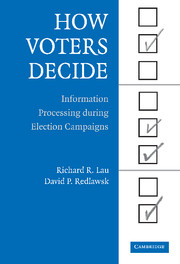Book contents
- Frontmatter
- Contents
- List of Tables and Figures
- Acknowledgments
- HOW VOTERS DECIDE
- I Theory and Methods
- II Information Processing
- III Politics
- 8 Evaluating Candidates
- 9 Voting
- 10 Voting Correctly
- 11 Political Heuristics
- IV Conclusion
- Appendix A Detailed Examples of Decision Strategies in Action
- Appendix B How the Dynamic Information Board Works
- Appendix C Overview of Experimental Procedures
- Appendix D Detailed Decision Scripts
- Appendix E Calculating the On-line Evaluation Counter
- References
- Index
- Titles in the series
10 - Voting Correctly
Published online by Cambridge University Press: 05 September 2012
- Frontmatter
- Contents
- List of Tables and Figures
- Acknowledgments
- HOW VOTERS DECIDE
- I Theory and Methods
- II Information Processing
- III Politics
- 8 Evaluating Candidates
- 9 Voting
- 10 Voting Correctly
- 11 Political Heuristics
- IV Conclusion
- Appendix A Detailed Examples of Decision Strategies in Action
- Appendix B How the Dynamic Information Board Works
- Appendix C Overview of Experimental Procedures
- Appendix D Detailed Decision Scripts
- Appendix E Calculating the On-line Evaluation Counter
- References
- Index
- Titles in the series
Summary
In the past two chapters, we have considered two important topics in the study of voting behavior, candidate evaluation, and vote choice. We have seen how our information processing approach provides valuable insights in these traditional political science topics. Now we turn to another inherently political topic, one that gets at the very heart of democracy. In Chapter 4, we described two related measures of correct voting, the first determined subjectively by voters themselves after a good deal of additional consideration of two of the candidates from the primary, the second a “normative-naive” measure, based on an objective determination of a match between the candidates and the voter's own attitudes and revealed information preferences during the campaigns. Although our first subjective measure is easier to defend normatively, in practice we must rely primarily on the second objectively determined measure, for the simple reason that we have it for all elections in all experiments; the first, voter-determined criterion is available only in the first two studies, and then only for two of the candidates from the primary election. Either one of these measures allows us to address questions that heretofore have been almost completely ignored by the scientific study of voting behavior: “How regularly do voters ‘get it right’?” and “What factors can we identify that lead to more or less correct voting?”
HOW OFTEN DO VOTERS GET IT RIGHT?
We reported in Chapter 4 that 70% of our primary voters voted correctly, by their own subjective determination.
- Type
- Chapter
- Information
- How Voters DecideInformation Processing in Election Campaigns, pp. 202 - 228Publisher: Cambridge University PressPrint publication year: 2006
- 2
- Cited by



